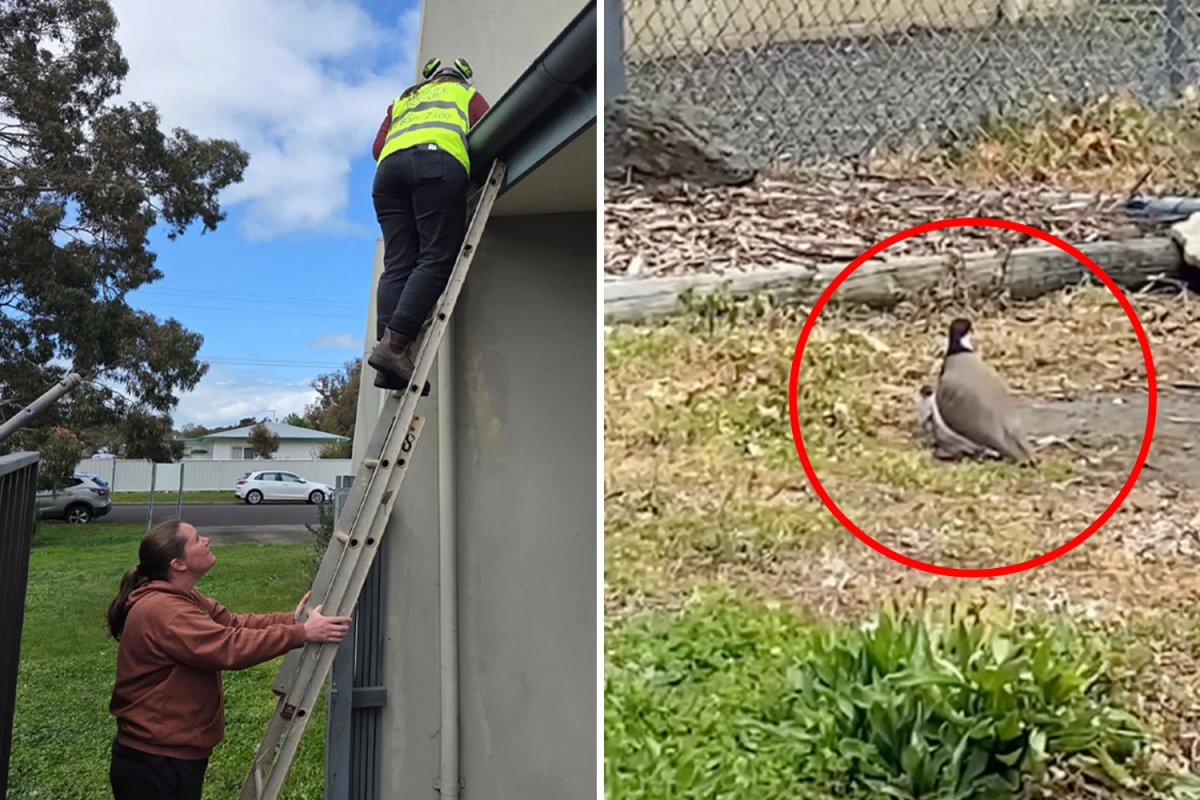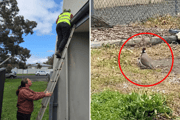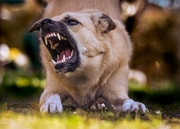
Rooftops aren’t just for pigeons anymore.
Wildlife rescuer, Kelly Brett, climbed onto a TAFE roof in Hamilton, Victoria, expecting the usual ground-level rescue—but what she found surprised her.
It was a glimpse into a growing trend among Australian suburbs’ feathered residents.
Kelly Brett’s unusual rooftop mission began with the urgent squawks of a distressed parent plover near a downpipe.
She first searched all the likely ground-level spots before realising she needed to look up.
What she found were two exhausted chicks—one stuck on the roof and the other trapped in guttering—teetering dangerously close to being washed away in recent rain.
'It's getting more common for plovers to nest on rooftops, especially flat rooftops, because as their territory is getting less and less with urban development, they're moving from ground dwelling to rooftops.'
Masked lapwings adapting to urban life
Masked lapwings are now choosing not only rooftops but also parks, school ovals, sports fields, and even supermarket car parks for nesting.
This behavioural shift spans Victoria and South Australia, demonstrating how these intelligent birds adapt to urban living.
Increased disturbances from pets, pedestrians, and vehicles at ground level have pushed them upwards in search of safer nesting spots.
The resilience of plover chicks
The chicks’ leap from nest to ground was a testament to natural resilience.
Much like ducklings from tree hollows, plover chicks can survive falls from considerable heights.
North American killdeer chicks, relatives of the masked lapwing, have been documented surviving descents from seven-story buildings when encouraged by their parents.
'They're pretty padded, like little fluffy pom poms, so they can fall from a fairly high distance,' Kelly said, noting that wind and rain complicated this particular rescue.
Did you know?
Plover chicks are born ready to run Unlike many baby birds, masked lapwing chicks have a full covering of down feathers and can leave the nest and feed themselves within hours of hatching, relying on their parents mainly for protection and guidance.
Protective behaviour and urban adaptation
During nesting season, defensive swooping is primarily a scare tactic and usually stops once chicks can fly—around six weeks after hatching.
Their wing spurs are not poisonous, though occasional nicks can occur, so sensible precautions are still important.
A broader urban trend
This rooftop trend reflects a broader urban adaptation among masked lapwings, which thrive in arid areas, coastlines, marshland, grassland, and open spaces near dams or lakes.
Some suburban pairs may never successfully breed due to human disturbance, making rooftop nesting a strategy to protect their young while maintaining access to open territory.
Under the National Parks and Wildlife Act 1972, masked lapwings are protected, and interfering with nests or eggs without a permit is an offence.
Kelly’s rescue was necessary due to imminent danger, but most chicks can safely jump from roofs without human help.
Kelly’s experience highlighted the extraordinary lengths these 'incredible parents' go to in order to raise their families in urban environments.
Even when nests appear inconvenient, giving the birds space for a few weeks allows humans and wildlife to coexist peacefully.
What This Means For You
Rooftop nesting among plovers is becoming increasingly common in Australian suburbs as these clever birds adapt to urban life.
Ground-level disturbances from pedestrians, pets, and vehicles are pushing them to seek safer spots, showing remarkable behavioural flexibility.
Plover chicks are highly resilient and can survive falls from significant heights, which means most rooftop nests do not require human intervention.
By being aware of these changes and taking simple protective measures, residents can safely coexist with these nesting birds and enjoy watching their unique urban adaptations.
If you found the story of rooftop plovers fascinating, there are other ways wildlife is adapting to human environments that are worth exploring.
From busy streets to suburban corners, young birds face new hazards as they navigate their surroundings.
One article highlights the dangers these chicks encounter and offers practical advice for keeping them safe.
Read more: New roadside threat has experts urging action: ‘Please be mindful'
Australian Plover Birds: Their Unique Diet Explored | ShunCulture — Discusses plovers’ urban nesting habits, including rooftops, parks, and supermarket carparks.
[URL='https://shunculture.com/article/what-do-australian-plover-birds-eat[/URL']https://shunculture.com/article/what-do-australian-plover-birds-eat[/URL]
Plovers — Provides information on plovers nesting on rooftops in urban environments for safety.
[URL='https://www.wires.org.au/wildlife-information/plovers[/URL']https://www.wires.org.au/wildlife-information/plovers[/URL]
Australian Plover Birds: Their Unique Diet Explored | ShunCulture — Explains masked lapwings’ preference for nesting in open suburban areas, including flat rooftops, parks, and sports fields.
[URL='https://shunculture.com/article/what-do-australian-plover-birds-eat[/URL']https://shunculture.com/article/what-do-australian-plover-birds-eat[/URL]
Plover Diet: What Do These Australian Birds Eat? | ShunCulture — Covers urban nesting choices of masked lapwings, including carparks, school ovals, and flat rooftops.
[URL='https://shunculture.com/article/what-do-plovers-eat-australia[/URL']https://shunculture.com/article/what-do-plovers-eat-australia[/URL]
Meet the masked lapwing, one of South Australia's other swooping birds — Highlights the adaptation of masked lapwings to urban settings across South Australia.
[URL='https://www.environment.sa.gov.au/goodliving/posts/2025/07/masked-lapwings-south-australia[/URL']https://www.environment.sa.gov.au/goodliving/posts/2025/07/masked-lapwings-south-australia[/URL]
Australian Plover Birds: Their Unique Diet Explored | ShunCulture — Notes that urban disturbances from pets, pedestrians, and vehicles can affect plover breeding success.
[URL='https://shunculture.com/article/what-do-australian-plover-birds-eat[/URL']https://shunculture.com/article/what-do-australian-plover-birds-eat[/URL]
Plovers — Details the natural resilience of plover chicks to falls, similar to ducks nesting in tree hollows.
[URL='https://www.wires.org.au/wildlife-information/plovers[/URL']https://www.wires.org.au/wildlife-information/plovers[/URL]
Killdeer Nature’s Master of Deception — Documents North American killdeer chicks surviving falls from significant heights, illustrating chick resilience.
[URL='https://globalbirdinginitiative.org/bird-species/killdeer/[/URL']https://globalbirdinginitiative.org/bird-species/killdeer/[/URL]
Meet the masked lapwing, one of South Australia's other swooping birds — Explains that defensive swooping behaviour stops once chicks can fly, around six weeks after hatching.
[URL='https://www.environment.sa.gov.au/goodliving/posts/2025/07/masked-lapwings-south-australia[/URL']https://www.environment.sa.gov.au/goodliving/posts/2025/07/masked-lapwings-south-australia[/URL]
Meet the masked lapwing, one of South Australia's other swooping birds — Describes swooping as primarily a scare tactic, with minimal contact, showing parental protective behaviour.
[URL='https://www.environment.sa.gov.au/goodliving/posts/2025/07/masked-lapwings-south-australia[/URL']https://www.environment.sa.gov.au/goodliving/posts/2025/07/masked-lapwings-south-australia[/URL]
Plovers — Clarifies that spurs on plovers’ wings are not poisonous.
[URL='https://www.wires.org.au/wildlife-information/plovers[/URL']https://www.wires.org.au/wildlife-information/plovers[/URL]
Meet the masked lapwing, one of South Australia's other swooping birds — Confirms urban myths about wing spurs being venomous are false.
[URL='https://www.environment.sa.gov.au/goodliving/posts/2025/07/masked-lapwings-south-australia[/URL']https://www.environment.sa.gov.au/goodliving/posts/2025/07/masked-lapwings-south-australia[/URL]
Meet the masked lapwing, one of South Australia's other swooping birds — Notes that spurs can occasionally nick humans during swooping.
[URL='https://www.environment.sa.gov.au/goodliving/posts/2025/07/masked-lapwings-south-australia[/URL']https://www.environment.sa.gov.au/goodliving/posts/2025/07/masked-lapwings-south-australia[/URL]
Meet the masked lapwing, one of South Australia's other swooping birds — Advises wearing a wide-brimmed hat and glasses or using an umbrella to protect against swooping.
[URL='https://www.environment.sa.gov.au/goodliving/posts/2025/07/masked-lapwings-south-australia[/URL']https://www.environment.sa.gov.au/goodliving/posts/2025/07/masked-lapwings-south-australia[/URL]
Meet the masked lapwing, one of South Australia's other swooping birds — Recommends keeping your head down and avoiding sudden movements to prevent aggravating swooping birds.
[URL='https://www.environment.sa.gov.au/goodliving/posts/2025/07/masked-lapwings-south-australia[/URL']https://www.environment.sa.gov.au/goodliving/posts/2025/07/masked-lapwings-south-australia[/URL]
Meet the masked lapwing, one of South Australia's other swooping birds — Suggests slowing down or dismounting bicycles to reduce bird agitation.
[URL='https://www.environment.sa.gov.au/goodliving/posts/2025/07/masked-lapwings-south-australia[/URL']https://www.environment.sa.gov.au/goodliving/posts/2025/07/masked-lapwings-south-australia[/URL]
Meet the masked lapwing, one of South Australia's other swooping birds — Advises travelling in groups to avoid being targeted by swooping birds.
[URL='https://www.environment.sa.gov.au/goodliving/posts/2025/07/masked-lapwings-south-australia[/URL']https://www.environment.sa.gov.au/goodliving/posts/2025/07/masked-lapwings-south-australia[/URL]
Masked lapwing—Wikipedia — Notes the adaptability of masked lapwings to arid and urban areas.
[URL='https://en.wikipedia.org/wiki/Masked_lapwing[/URL']https://en.wikipedia.org/wiki/Masked_lapwing[/URL]
Meet the masked lapwing, one of South Australia's other swooping birds — Details the various habitats of masked lapwings, including coastlines, marshland, grassland, and near dams or lakes.
[URL='https://www.environment.sa.gov.au/goodliving/posts/2025/07/masked-lapwings-south-australia[/URL']https://www.environment.sa.gov.au/goodliving/posts/2025/07/masked-lapwings-south-australia[/URL]
Masked lapwing—Wikipedia — States some suburban masked lapwings may fail to breed due to human disturbance.
[URL='https://en.wikipedia.org/wiki/Masked_lapwing[/URL']https://en.wikipedia.org/wiki/Masked_lapwing[/URL]
Meet the masked lapwing, one of South Australia's other swooping birds — Explains legal protections under the National Parks and Wildlife Act 1972 and that interference with nests or eggs is an offence.
[URL='https://www.environment.sa.gov.au/goodliving/posts/2025/07/masked-lapwings-south-australia[/URL']https://www.environment.sa.gov.au/goodliving/posts/2025/07/masked-lapwings-south-australia[/URL]
Meet the masked lapwing, one of South Australia's other swooping birds — Notes that relocating nests often leads to egg abandonment and requires a permit.
[URL='https://www.environment.sa.gov.au/goodliving/posts/2025/07/masked-lapwings-south-australia[/URL']https://www.environment.sa.gov.au/goodliving/posts/2025/07/masked-lapwings-south-australia[/URL]
Plovers — Advises interference with chicks should only occur in cases of absolute necessity.
[URL='https://www.wires.org.au/wildlife-information/plovers[/URL']https://www.wires.org.au/wildlife-information/plovers[/URL]
Plovers — Explains that most chicks can safely jump from rooftops without human intervention.
[URL='https://www.wires.org.au/wildlife-information/plovers[/URL']https://www.wires.org.au/wildlife-information/plovers[/URL]
Meet the masked lapwing, one of South Australia's other swooping birds — Encourages giving birds space to maintain harmony even if nests are in inconvenient spots.
[URL='https://www.environment.sa.gov.au/goodliving/posts/2025/07/masked-lapwings-south-australia[/URL']https://www.environment.sa.gov.au/goodliving/posts/2025/07/masked-lapwings-south-australia[/URL]
Have you noticed changes in where birds are nesting in your local area?







